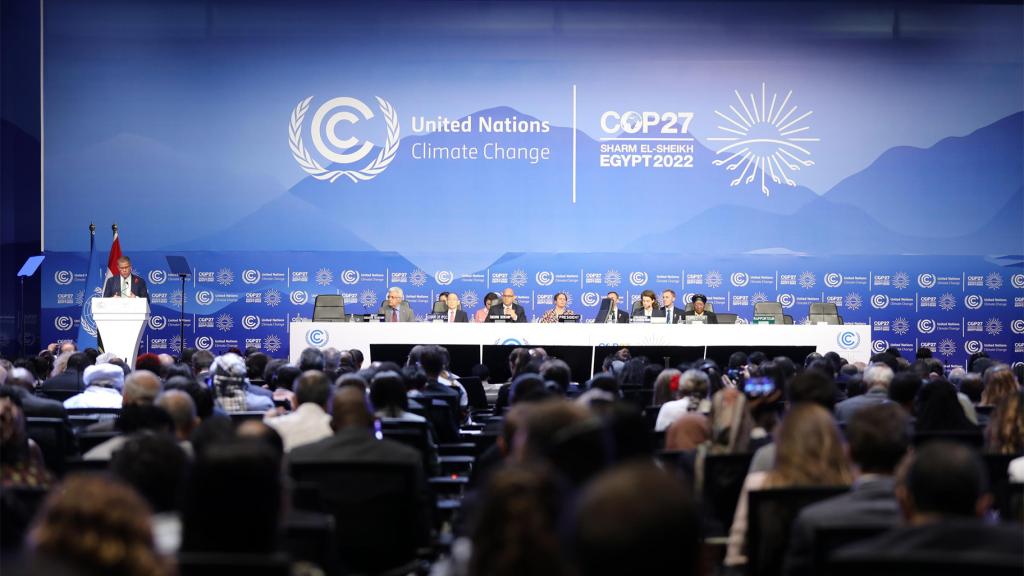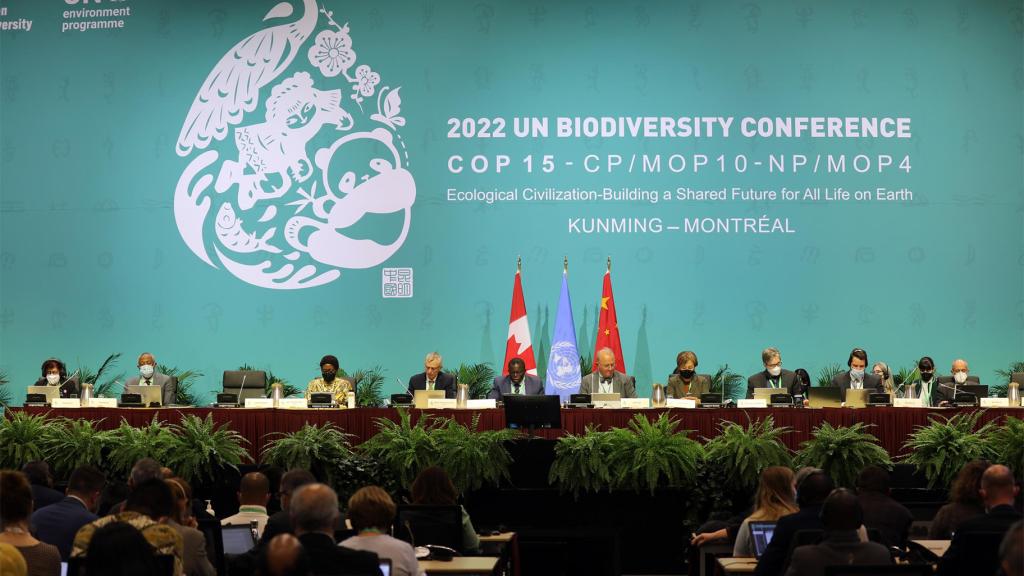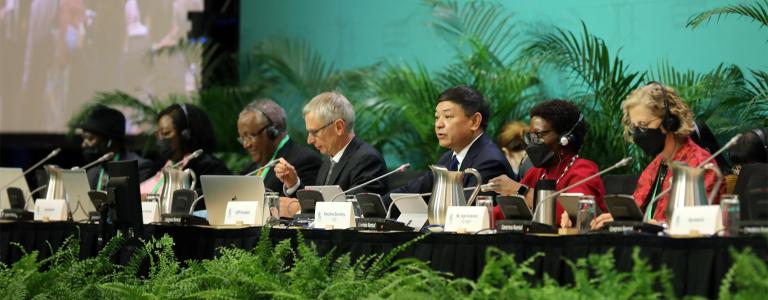From Sharm el-Sheikh to Montreal: Seizing the moment for the biodiversity–climate nexus at COP 15
The Post-2020 Global Biodiversity Framework negotiations at the UN Biodiversity Conference in Montreal represent a once-in-a-decade moment to set an ambitious agenda for biodiversity conservation. Building on the momentum of COP 27, enhancing synergies between the biodiversity and climate agendas is more important than ever.
With the once-bustling conference halls in Sharm el-Sheikh now quiet after an eventful 2-week UN Climate Change Conference (COP) 27, many familiar faces are now meeting again in Montreal from December 3 to 19, 2022, for the UN Biodiversity Conference COP 15. During these talks, Parties to the Convention on Biological Diversity (CBD) are seeking to finalize global biodiversity goals for 2050 as well as the intermediary targets for 2030, which will form part of the Post-2020 Global Biodiversity Framework (GBF).
The GBF is envisioned to be a blueprint both within and outside the UN system for catalyzing, enabling, and accelerating urgent and transformative actions to protect biodiversity, reduce threats, and meet people’s needs through the sustainable use of wild species—a "Paris Agreement" for nature, as some call it. At COP 27 last month, key UN officials already raised the point that protecting biodiversity is protecting the Paris Agreement, as climate change and biodiversity loss are inherently intertwined, as are the human responses to combat the twin crises.
The GBF’s predecessor, the Strategic Plan for Biodiversity 2011–2020 and its associated Aichi Targets, drew an essential linkage between ecosystem health and climate change, including a target of restoring at least 15% of degraded ecosystems to contribute to climate mitigation and adaptation (Aichi Target 15). At COP 15, the world will once again look to negotiators, civil society observers, and stakeholders for a set of ambitious targets that would facilitate urgent actions to address biodiversity loss, ecosystem degradation, and climate change.
One of the key integrated approaches to address the twin crises involves nature-based solutions (NbS). Much has happened in the climate and biodiversity landscapes since our article on how to get NBS right. One year later, we review why the two crises are interlinked, what progress has been made in reaching a common definition for NbS, how COP 27 has helped set the stage for CBD COP 15, and what this all means for the GBF negotiations in Montreal.
How COP 27 and COP 15 Are Paving the Way for Joint Action on Climate and Nature
Although scientists agree that the biodiversity loss and climate crises are intertwined, these issues have been treated separately in the policy world ever since the 1992 Rio Earth Summit. That conference saw the emergence of the United Nations Framework Convention on Climate Change (UNFCCC) and the CBD, along with calls from governments to negotiate a third UN convention that would address land degradation, which later became the United Nations Convention to Combat Desertification (UNCCD). These are known collectively as the Rio Conventions.

A great opportunity emerged in having COP 27 precede this year’s biodiversity COP 15, given that the former event has already signalled the urgent need to form stronger synergistic actions between these policy areas as countries aim to finalize and adopt a post-2020 GBF in Montreal. Here are four recent advancements that are paving the way for more joint action on climate and nature:
1. Science Is Telling Us We Cannot Address Climate Change Without Biodiversity Conservation—and Vice Versa.
Climate change is one of the key drivers of biodiversity loss. It increases the severity and frequency of hazards such as droughts and floods, changes the ranges in which species can thrive, alters food webs, and affects times and patterns of reproduction. Degradation of natural ecosystems—particularly deforestation—both releases enormous volumes of greenhouse gases and reduces the ability of natural systems to continue to absorb carbon from the atmosphere and protect us from disasters.

Image from biodiversitystripes.info. Biodiversity stripes created by Miles Richardson (findingnature.org.uk) based on the warming stripes developed by Ed Hawkins. Data from LPI 2022 (Living Planet Index database, 2022).
A joint analysis by global climate change and biodiversity experts of the Intergovernmental Panel on Climate Change (IPCC) and the Intergovernmental Science-Policy Platform on Biodiversity and Ecosystem Services (IPBES) delivers one central message: It is essential for countries to focus on integrated approaches such as NbS.
We cannot achieve the goals of the Paris Agreement without drastically reducing the threat to biodiversity. Equally, we cannot meet the proposed targets and goals of the Post-2020 Global Biodiversity Framework without more ambitious emission reduction targets and more urgent adaptation action.
2. A New Common Understanding for NbS Offers New Opportunities for Linkages
NbS have faced criticism in the past, which largely stems from a lack of a globally agreed upon definition, standards, and principles guiding the implementation of these solutions. This vacuum opened NbS up for harmful interpretations and misguided applications.
However, in March 2022, at the resumed Fifth United Nations Environment Assembly (UNEA 5.2), governments formally agreed on a definition of NbS and recognized the important role these solutions can play in the global response to climate change and biodiversity loss.
The UNEA 5.2 resolution formally adopted the definition of nature-based solution as "actions to protect, conserve, restore, sustainably use and manage natural or modified terrestrial, freshwater, coastal and marine ecosystems, which address social, economic and environmental challenges effectively and adaptively, while simultaneously providing human well-being, ecosystem services and resilience and biodiversity benefits."
The decision by countries to adopt a multilaterally agreed definition of NbS is a big step forward for climate and biodiversity. It underscores the value of NbS as effective tools to jointly address climate change and biodiversity loss. It also presents a monumental step forward in developing a common understanding of what NbS are and the social and environmental safeguards that must be adhered to in their implementation.
3. Momentum Gained at COP 27 Creates Ripples for COP 15
The biodiversity COP has big ambitions, with a vision that "by 2050 biodiversity is valued, conserved, restored and wisely used, maintaining ecosystem services, sustaining a healthy planet and delivering benefits essential for all people."

COP 27 spurred this momentum for COP 15 by underlining "the urgent need to address, in a comprehensive and synergetic manner, the interlinked global crises of climate change and biodiversity loss." For the first time, negotiators included dedicated sections on oceans, forests, and agriculture in the COP 27 cover decision—known as the Sharm el-Sheikh Implementation Plan. Specifically, the cover decision includes the term NbS within the forest section, emphasizing the importance of ensuring social and environmental safeguards, something IISD has advocated for as a crucial factor in delivering effective and sustainable NbS. Cover decisions provide a high-level political mandate to countries and signal the importance of an issue—meaning that NbS could be a regular element as part of future climate negotiations.
COP 27 also saw the launch of several new multi-country initiatives for tackling deforestation and restoring carbon-rich and biodiverse ecosystems, as well as the convening of the Finance Forum on NbS to close the NbS finance gap. These developments will also help accelerate the GBF’s major goal of protecting 30% of the planet’s land and sea areas by 2030 through area-based conservation.
4. Promoting Coherence Between National Climate and Biodiversity Strategies
Both conventions have created instruments to give countries the flexibility to develop their own national strategies to achieve the commitments they have made in these international forums. For the Paris Agreement, these are called Nationally Determined Contributions (NDCs) and National Adaptation Plans (NAPs) to address climate change mitigation and adaptation. Similarly, for the CBD, National Biodiversity Strategy and Action Plans (NBSAPs) allow countries to formulate and outline their strategies for protecting biodiversity and ecosystems.
Although national instruments and policies have been developed separately under these two conventions to make progress in tackling the issues, this does not impede governments from creating greater coherence and alignment between national commitments.
Given the current emphasis on NbS and the importance of protecting and restoring nature to address climate change, overlaps between the measures included under NDCs, NAPs, and NBSAPs are inevitable. For instance, commitments to protect and restore hectares of forests are not only a climate measure to sequester carbon and buffer against the impacts of extreme weather events, but also a conservation measure to protect biodiversity.
Recent international efforts such as the Leaders Pledge for Nature to build better bridges between the climate and nature are playing a key role in propelling and harmonizing these more coordinated climate-biodiversity responses at the national level.
CBD COP 15 Is a Once-in-a-Decade Moment to Set an Ambitious and Synergistic Agenda
As CBD parties iron out the details of the GBF in Montreal, negotiators must keep in mind the intricate linkages between biodiversity and climate change and design the GBF in a way that encourages joint actions. Below, IISD experts have assembled a list of key recommendations on setting the targets of the GBF that would build on the momentum of COP 27 and pave the way for a nature-positive, resilient future.
Recognize the right to a safe, clean, healthy, and sustainable environment. At COP 27, people’s right to a clean, healthy, and sustainable environment was recognized explicitly in the Sharm el-Sheikh Implementation Plan. This recognition was in line with the recently adopted UN General Assembly resolution (A/76/L.75) and UN Human Rights Council resolution (48/13). Negotiators at COP 15 should build on this momentum and explicitly include “the fulfilment of the right to a safe, clean, healthy and sustainable environment” as one of the key objectives of conserving and sustainably managing biodiversity in Section B and the proposed Goal B of the GBF.
Build in ambitious climate mitigation and adaptation targets for the biodiversity–climate nexus. The proposed Target 8 of the GBF should include clear and measurable commitments relating to climate mitigation and adaptation and disaster risk reduction. It should also recognize the importance of integrated approaches to addressing biodiversity degradation and climate change, including NbS and other ecosystem-based approaches. However, it is equally crucial to recognize that NbS cannot be a substitute for rapid, deep, and sustained emissions reduction measures. Without ambitious commitments to fossil fuel phase-out or the elimination of environmentally harmful subsidies (including fossil fuel subsidies), NbS alone cannot successfully address the twin crises.
Establishing robust social safeguards for NbS is key. Throughout the GBF, references to integrating human rights-based and gender-responsive approaches and social inclusion considerations in the planning and implementation of biodiversity actions are central to the legitimacy and integrity of the Framework. Robust social safeguards should be at the heart of NbS planning and implementation to protect people’s rights, especially those of Indigenous Peoples and local communities, and ensure equitable benefit-sharing, leaving no one behind. These safeguards are especially critical in the context of the proposed "30x30" target for ecosystem conservation.
Encourage synergistic implementation of biodiversity–climate actions. Amplifying and promoting the joint financing and implementation of projects that deliver multiple goals under the GBF and the Paris Agreement will further enhance synergies between the two conventions. This includes encouraging the joint planning and implementation of the NBSAPs and NAPs, as well as mobilizing public and private sector finance for NbS to fulfill the estimated USD 384 billion per year of investment needed for NbS by 2025. These considerations should be reflected in the GBF Targets 14–22.
Enhance cooperation and joint programming between the Rio Conventions. The UNEA’s definition of NbS represents a leap forward in reaching a legally binding definition for NbS within international law. With this newfound momentum, it is time for the three Rio Conventions—the CBD, UNFCCC, and the UNCCD—to create a shared understanding of the values, impacts, and limitations of NbS, as well as a set of common guiding principles and safeguards needed during their planning and implementation. It is also time for enhanced cooperation to assess the complementarity and compatibility between the goals and targets of each convention’s legal instruments and financing facilities, including the GBF, the Paris Agreement, the Global Environment Facility, and other entities of the financial mechanism, and the UNCCD’s Global Mechanism.
*The image of the dais from the COP 15 plenary used for the top banner of this article is by IISD/ENB | Mike Muzurakis.
You might also be interested in
The Global Biodiversity Framework's "30x30" Target: Catchy slogan or effective conservation goal?
In the lead-up to COP 15, we take a closer look at one of the key targets included under the proposed Global Biodiversity Framework.
Seeking Clarity on Nature-Based Climate Solutions for Adaptation
This guidance note clarifies the concepts behind nature-based solutions (NbS), nature-based climate solutions (NBCS), and ecosystem-based adaptation (EbA).
Addressing Biodiversity Loss and Climate Change: Three ways adaptation planning can help
Biodiversity loss and climate change must be addressed urgently and ambitiously – until now, these agendas have remained separate, but neither will be resolved unless both are tackled together.
What’s Next After UNEA-6: Why “synergies” is more than a buzzword
In an era marked by escalating environmental challenges and geopolitical tension, the Sixth United Nations Environment Assembly (UNEA-6) called for more cooperation to tackle the triple planetary crisis.
